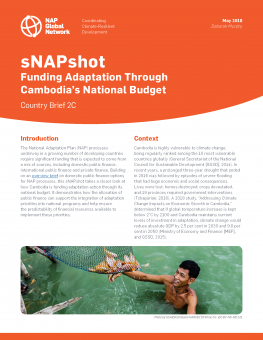
sNAPshot | Funding Adaptation Through Cambodia’s National Budget
The National Adaptation Plan (NAP) processes underway in a growing number of developing countries require significant funding that is expected to come from a mix of sources, including domestic public finance, international public finance and private finance.
The National Adaptation Plan (NAP) processes underway in a growing number of developing countries require significant funding that is expected to come from a mix of sources, including domestic public finance, international public finance and private finance.
Building on an overview brief on domestic public finance options for NAP processes, this sNAPshot takes a closer look at how Cambodia is funding adaptation action through its national budget. It demonstrates how the allocation of public finance can support the integration of adaptation priorities into national programs and help ensure the predictability of financial resources available to implement these priorities.
Key Lessons
- Political leadership is critical to domestic financing of adaptation action. High-level support from Cambodia’s political leaders, including the Minister of Environment who leads the National Council for Sustainable Development (NCSD), has enabled the development of institutions and processes that prioritize adaptation actions and the allocation of domestic funds for adaptation.
- Expenditure data needs to be combined with data on climate adaptation outcomes to assess the effectiveness and efficiency of public investments. Cambodia is establishing a monitoring and evaluation framework that will include climate-related indicators in the national budget, including climate finance indicators and climate outcomes.
- Some climate change actions are supported with existing budget funds that are not identified as climate finance. Identification of all domestic public finance that addresses climate change enables informed decision making. This is also true for external funding, whereby the amount of external finance that supports adaptation could be increased by mainstreaming climate change into typical development projects funded by donors. For example, the Climate Public Expenditure Review found that many agriculture projects funded by donors are not aligned with the sector’s climate change priorities (Kingdom of Cambodia, 2016).
- Lack of finance is a critical barrier to the NAP process. Cambodia has improved its capacity to mobilize, spend and track public finance for the NAP process. Yet a lack of finance remains a critical barrier impacting the implementation of adaptation actions. Despite increased allocations of domestic funding, international climate finance will continue to be a large contributor to the implementation of Cambodia’s NAP.
- “Domestic resources can mobilise a more immediate, nationally driven response to climate change, and when aligned with external funding sources, can gain a much greater impact” (Tchaparian, 2016). The integration of programs and domestic and international funding sources improves the effectiveness of the NAP process (Tchaparian, 2016).
- Sustainable financing is based on country ownership and a long-term view. Some officials in key institutions need to be trained and provided with training-of-trainer courses on climate finance to ensure local ownership and buy-in. Tracking and measuring domestic budget allocations for adaptation is not easy. It is a process, and Cambodia has ensured that public officials use their knowledge and share information on climate financing and budgeting across several budget cycles (CCCA, 2016).
References
Cambodia Climate Change Alliance (CCCA). (2016). Cambodia needs to seize the opportunities in climate finance. Khmer Times. Retrieved from https://www.khmertimeskh.com/news/23967/cambodia-needs-toseize-the-opportunities-in-climate-finance/
Kingdom of Cambodia. (2016). Report on Climate Public Environment Review, 2015. Phnom Penh: Ministry of Economic and Finance. Retrieved from http://www.camclimate.org.kh/en/documents-and-media/library/ category/39-financing.html
Tchaparian, S. (2016). Closing the climate finance gap in Cambodia: Could training be the simple answer? Retrieved from https://unitar.org/medium/closingclimate-finance-gap-cambodia-could-training-besimple-answer
Participating experts
You might also be interested in
Progress on Vertical Integration in National Adaptation Plan Processes
This synthesis report presents an analysis of how countries are advancing vertical integration in national adaptation plan processes.
Four Key Elements to Ensure a Successful Global Goal on Adaptation
As the final rounds of negotiations on the GGA kick off at COP 28, a looming question remains: Will it be comprehensive enough for countries to implement in the years ahead?
Public Engagement on Climate Change Adaptation
This report provides an introduction to public engagement on climate change adaptation for decision-makers involved in leading national adaptation plan (NAP) processes.
The Coral Gardeners of Saint Lucia: Local heroes against coral bleaching
Coral gardeners in Saint Lucia are working together to save reefs from the devastating effects of climate change through a flagship project under the island's National Adaptation Plan (NAP).